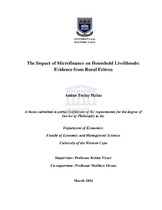| dc.description.abstract | Eritrea, a relatively young African nation, is one of the least developed countries in the world. Its economy is predominantly dependent on subsistence agriculture and the level and magnitude of poverty is more severe in rural areas. The formal financial sector is underdeveloped, state-owned, far from being competitive, and limited in terms of depth and breadth as measured by the relevant financial sector development indicators. To address the limitations of the formal banking sector and to help fill the financing gap, and improve the general livelihood of those at the lower income group, the Government of Eritrea introduced a Saving and Microcredit Programme (SMCP) in 1996 for which no scientific study measuring its impact has been done at the household level. The study was conducted in rural areas to find out whether the SMCP as a microfinance institution has improved the livelihood of its clients. The specific objectives of the study were to describe the characteristic feature of rural livelihoods in terms of the resources owned, the strategies pursued and outcomes achieved, identify and examine the determinants of household participation in the SMCP and finally assess the impact of participation in SMCP on household livelihoods. The study employed a quasi-experimental cross-sectional survey design involving structured and semi-structured questionnaire administered to 500 respondents of whom 200 represented the treated group and 300 the controlled group. Logit regression was employed to identify the factors that determine household participation in the SMCP. In regard to this, age of the client household, household size, marital status, level of education of the client household, the size of first round loan, entrepreneurial experience, type of loan product offered by the institution, ownership of livestock and microenterprise, the perception of the client on involuntary deposits, the occurrence of a negative events (shock) to the household and village access to electricity were found to have statistically significant effect on the household‟s probability to participate in the SMCP. Furthermore, the marginal effects were also computed to evaluate the contribution of each of these factors to the likelihood of participating in the SMCP. A propensity score matching model was applied to assess the impact of the programme on the livelihood of its clients. The findings reveal that participation in the SMCP has a significantly higher average treatment effect on the treated (ATT) households. Profits generated from off-farm and small microenterprises, the values of household and livestock assets, food and non-food consumption expenditures and nutrition quality, were found to be on average higher for the treated households than for the controlled households. Therefore, it could be argued that the provision of micro financial resources has significant positive effects on household livelihood outcomes. The study has important social and economic policy implication regarding the role of finance in rural development. | en_US |

